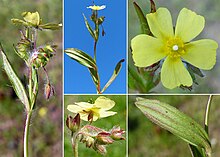| Tuberaria lignosa | |
|---|---|

| |
| Scientific classification | |
| Kingdom: | Plantae |
| Clade: | Tracheophytes |
| Clade: | Angiosperms |
| Clade: | Eudicots |
| Clade: | Rosids |
| Order: | Malvales |
| Family: | Cistaceae |
| Genus: | Tuberaria |
| Species: | T. lignosa |
| Binomial name | |
| Tuberaria lignosa (Sweet) Samp. | |
| Synonyms | |
| |
Tuberaria lignosa is a species of perennial rock-rose native to the western Mediterranean region.
Description
Tuberaria lignosa is a perennial herb, often woody towards the base. It reaches a height of 57 centimetres (22 in) and branches freely. Its leaves are simple, 3–10 cm (1–4 in) long and 0.9–3.4 cm (0.4–1.3 in) wide. The inflorescence is lax, with each flower 2–3 cm (0.8–1.2 in) in diameter.
Distribution and ecology
Tuberaria lignosa is found around the western Mediterranean Basin, in parts of Italy, France, mainland Spain, Portugal, Morocco, Tunisia, Algeria and the Canary Islands.
Taxonomy
The species was first described by Carl Linnaeus in his 1753 work Species Plantarum, as "Cistus tuberaria". It was later transferred to the genus Helianthemum, and when Michel Félix Dunal erected Helianthemum sect. Tuberaria in 1824, he designated "Helianthemum tuberaria" as its type species. In 1827, Robert Sweet published a description of "Helianthemum lignosum", but this name was invalid as a junior synonym of H. tuberaria. In 1836, Édouard Spach raised this subgenus to the rank of genus as Tuberaria; because the International Code of Nomenclature for algae, fungi, and plants forbids tautonyms (such as "Tuberaria tuberaria"), the next oldest available name has to be used. In 1922, Gonçalo Sampaio introduced the combination Tuberaria lignosa, which is the name generally used today. Some botanists consider the species part of the genus Xolantha, in which case it is known as Xolantha tuberaria.
Medical research
The plant has been researched for medical purposes in cancer treatment. An aqueous extract of Tuberaria lignosa inhibited cell growth, altered the cell cycle profile, and induced apoptosis of NCI-H460 Tumor Cells.
References
- "Tuberaria lignosa (Sweet) Samp". The Plant List. Retrieved 17 April 2015.
- M. J. Gallego (2005). "Xolantha Raf." (PDF). Plumbaginaeae (partim) – Capparaceae. Flora Iberica. Vol. 3 (2nd ed.). pp. 351–365. ISBN 8400083598.
- "Tuberaria lignosa". Germplasm Resources Information Network. Agricultural Research Service, United States Department of Agriculture. Retrieved 18 April 2015.
- Pereira, Joana; Lopes-Rodrigues, Vanessa; Xavier, Cristina; Lima, M.; Lima, Raquel; Ferreira, Isabel; Vasconcelos, M. (2016). "An Aqueous Extract of Tuberaria lignosa Inhibits Cell Growth, Alters the Cell Cycle Profile, and Induces Apoptosis of NCI-H460 Tumor Cells". Molecules. 21 (5): 595. doi:10.3390/molecules21050595. PMC 6273798. PMID 27164073.
External links
- Dunal's publication of Helianthemum sect. Tuberaria in de Candolle's Prodromus
| Taxon identifiers | |
|---|---|
| Tuberaria lignosa |
|
| Helianthemum lignosum | |